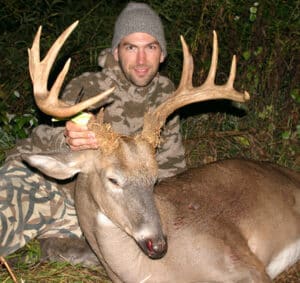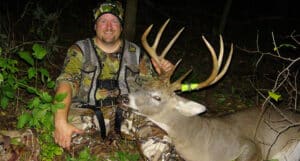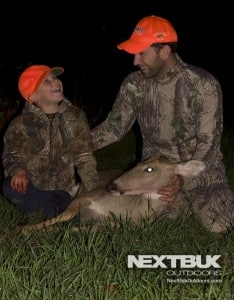With September around the corner, deer seasons will start opening and others will be here soon after. I’ll be hunting the Wisconsin archery opener this year, September 12, on a combination of both public and private grounds for a few days. I’m really excited about the bucks we’re all onto here at NextBuk. I’ll even drop a hint that should one of our guys drop the one he’s after, well, some records may fall. It’s almost game time! Continuing my year around approach series of articles, here are 5 tips for September that will help you consistently kill big whitetail bucks:
- Observe
Heading into season, sit back and observe, if you can. Don’t invade your hunting areas just yet. Remember, you need to hunt based on what a deer is doing right then, not last week or last month, so the closer you get to the season, the more your observations will clue you in on where exactly you should be targeting. I recently had breakfast with a friend that’s been watching a river in the evenings so he can determine where bucks are leaving their bedding. This is a long ways from farm fields he’s been shining them in at night during the summer. Smart!! He’s staying back but he’s getting in (by boat) just close enough to observe. Scouting from afar right now is your friend. - Re-Locate Your Bucks
September is the month when velvet comes off and testosterone goes up. Bucks start breaking away from their friendly bachelor groups and becoming more solitary. Food sources often change. The lush, green soybean fields you’ve been watching bucks in the past couple months are now yellowing and drying. Deer begin to focus on other things like acorns, apples, and corn. It’s easier said than done when your buck goes missing, but this is the fun part to me…the part where you put your actual hunting skills to action! If you’ve judiciously studied your deer over this past year of scouting, you know your buck’s track. You know one or more of his actual beds. Study the surrounding food and water options. Study the pressure in the area. Walk or drive roads to cut tracks coming and going. Reposition trail cameras to suspected new areas, but try to avoid actual stand locations. Keep disturbance to a minimum as you scout to determine what your buck is doing this month. -
Spot checking a natural water puddle in Wisconsin’s early season led me to this nice buck that we featured in Hill Country Bucks.
Spot Check
For those of us that are going to be hunting this month, it’s time to spot check! We talk about this in all of our hunting videos because it’s critical. Spot checking gives you the most recent information. This is one of the final pieces of the puzzle aside from making the actual shot. Spot checking is what deterimines what stand you will hunt that day and why. A typical scenario for me is to quickly walk (or try riding a mountain bike) the perimeter of a field, checking for fresh browse indications and tracks. This doesn’t mean I’m looking for a spot to setup on the field edge. It usually just means I’m looking for an indicator that my target buck is using that food source. If so, I go back to my knowledge of where he beds and I setup closer to his bedding with the clue that I know where he might be heading when he leaves it.
It can also mean actually back-tracking some trails that go into food sources, trying to find which trail he’s using to get to the food source. This is more aggressive than most because you need to understand that by doing this, you’re educating the deer to your presence. The key, however, is to not go in farther than you’re willing to setup. Shining is another good way to spot-check. You may know of a buck in the area based on summer scouting, but when it comes time to pick a stand, a quick run around your area at night with a spotlight can show you which food he’s using, enabling you to pull upon your other scouting to determine a point of interception. Your post season scouting knowledge, combined with this current spot checking is what will get you in the game on all of your hunts! -
Pro staffer, Shawn Vanlandingham, carefully spot-checked an area of public ground in Wisconsin and found the sign he wanted to, leading to this great trophy whitetail.
Dress Rehersal
By now your muscles are in good shooting shape. As season draws near and opens, don’t forget to keep practicing! Now is the time to really mimic a hunting scenario. Put your field tips away and shoot only practice broadheads. Wear your clothes you’ll actually be hunting in (or very close to it). Pay special attention to gloves and facegear as they can really affect accuracy with and without. I will often limit myself to one shot, or maybe one shot each from a few yardages is all. The first one is the one that counts anyway! Develop and practice a pre-shot routine. Mentally and physically rehearse how you’ll position yourself. Where will you have your rangefinder and at what point will you use it? Practice clipping on your release without looking. This pre-shot routine is important, right down to the mental self-talk that should go on. For me, I’m constantly repeating two things: know the range, and pick a spot. I say that over and over to myself. When I’m certain of the distance, I focus on the spot. Everything else will take care of itself based on your training. So focus, get as realistic in your practice as you can, and the moment of truth won’t feel as foreign. -
Take a Kid Hunting!
For me here in Michigan, September means a special youth hunt and I really cherish the 2 days that I get to take my kids out. Michigan’s youth season is September 19-20 this year. Jacob and I have a date with a couple bucks that eluded his effective range last year. It’s priceless to get to see the fresh perspective a child brings to hunting. Although it’s debatable whether they should be able to shoot bucks, just focus on having fun with the child and I guarantee a fun time. Check out Five Reasons to Support Youth Hunts for more on why I think these hunts are great. - Bonus Tip: Food Plots
By September, most of us will have our food plots in. Make a point to put a small cage or two in yours to observe just what kind of impact the deer are having on your plot. Take note of what they’re eating and when and if they seem to have a preference of one variety over another. I purposely planted a bunch of things in mine in August so that I can better see what the deer like more. I planted Frigid Forage, Real World Wildlife Seed, Killer Food Plots, Buck Forage Oats, and a couple other local varities for comparison. More on results later!
Mistakes to Avoid in September
September is the month when the juices really get flowing. It’s when my “not-so-serious” hunting buddies start getting after it and scouting and hanging stands. This is typically a mistake if season’s not open yet because 1) they’re often hanging stands based on current sign and the deer will be doing something different come season, and 2) they’re invading their buck hangouts and alerting deer of their presence before you can even hunt. You typically only get one chance at a good buck before he’s onto you, so don’t hurt your chances by getting too eager before it’s time.
If your season opens in September, remember to be patient but ready! It’s a very hard thing to NOT hunt a spot because conditions aren’t right. Don’t screw up what could be an easy chance at an undisturbed early season trophy by hunting your spots in the wrong conditions.
Good luck with your next buck!



